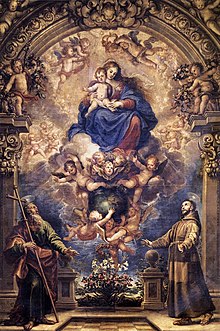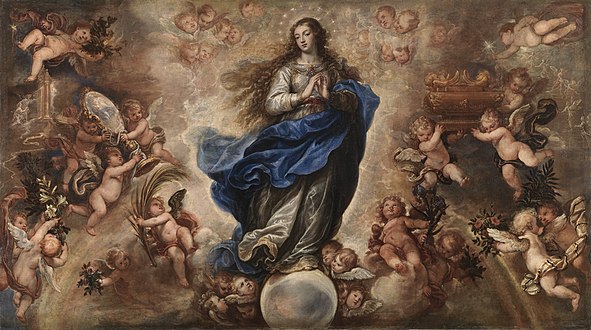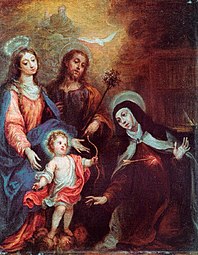Francisco Rizi

Francisco Rizi ( de Guevara ) (born April 9, 1614 in Madrid ; † 1685 in the Escorial ) was a Spanish painter of Italian origin, and one of the pioneers and most important exponents of Madrid's high baroque from the mid-17th century.
biography
Francisco Rizi was the last of eleven children of the Italian painter Antonio Ricci and Gabriela Guevara; the typical Italian form of the name "Ricci" was translated into Spanish as "Rizi". His father was originally from Bologna and had come to Spain with Federico Zuccaro to work in the monastery palace of the Escorial . Francisco's brother Juan Andrés was also a painter and art theorist.
Francisco Rizi initially received his training from Vicente Carducho . As early as 1638 he had relationships with the royal court - possibly thanks to his teacher Carducho - and in 1639 worked in the old Alcázar in Madrid on the decor of the Salón dorado ("Golden Hall"), also known as De las comedias (Comedy Hall ).
He often created festive and stage decorations, including 1649 on the occasion of the arrival of the royal wife Maria Anna of Austria in Madrid, together with Alonso Cano , Pedro de la Torre , Sebastián Herrera Barnuevo and others. a. From 1649 he also worked as a stage painter for the performances in the theater of the Buen Retiro Palace, of which he was director for decades. According to Palomino , he turned out to be a “great architect and master of perspective ” (“ grandísimo arquitecto y perspectivo ”).
The experience in architecture and perspective that he gained as a decorative painter, Rizi transferred with equal success to religious paintings for numerous churches in and around Madrid and Toledo; here he created both frescoes and altarpieces in oil .
He was particularly closely connected to the Cathedral of Toledo : He was officially appointed painter of the cathedral in June 1653 and created all kinds of work for it, including festive decorations for the Semana Santa (1668–1669). This monument was particularly praised by Palomino for its mystical allusions, and he described Rizi in this context as “very educated, especially in the human sciences (see: humanism ); and so his works and ideas were always very well founded ”.
He worked with Juan Carreño de Miranda on the dome frescoes of the octagon of Toledo Cathedral , with whom he had a fruitful collaboration in the 1660s.
In 1656 Francisco Rizi was officially appointed painter to King Philip IV and from 1661 he was allowed to live in the Alcázar of Madrid. His collaboration with Carreño began in 1659 when they worked with the Bolognese quadrature painters Agostino Mitelli and Angelo Michele Colonna on the ceiling of the Hall of Mirrors in the Alcázar, under the supervision of Diego Velázquez . The subject of these frescoes was the story of Pandora ; they were destroyed in the fire of the Alcázar in 1734 along with many other art treasures. Other works from Rizi's collaboration with Carreño have also disappeared today.
Rizi's relations with the royal court deteriorated in 1669 when the post of curator in the Escorial was given to Sebastián Herrera Barnuevo , and his colleague Carreño de Miranda was appointed the king's painter and two years later (1671) a chamber painter. Rizi felt ignored and hurt and in 1673 addressed a "famous" memorial to the queen widow Maria Anna, in which he complained and listed all the works he had created for the royal family and the court. As a small compensation, Maria Anna granted him a pension in 1675. Relations improved so much that immediately after Charles II's marriage to Marie Louise d'Orléans , he painted two equestrian portraits of the bride and groom, which he gave to the Toledo City Council in early 1680 (now in the town hall). Until the deed of donation was found, these two portraits were considered works by Carreño de Miranda, although Rizi did not have his portrait painting qualities and they are rather mediocre works.

Aside from his temporary problems with the court, Rizi continued to receive significant assignments from the Church. One of the most artistically important is the decoration of the Capilla del Milagro (Wonder Chapel) in the Monasterio de las Descalzas Reales , which he created in fresco and oil together with Dionisio Mantuano in 1678, and which represents a “definitive triumph of illusion painting”.
In 1685 Rizi was commissioned to paint the Sagrada Forma for the sacristy of the monastery palace of El Escorial, which he could no longer finish because he suddenly died on August 2nd - the painting was completed by his pupil Claudio Coello .
At the time of his death, Rizi was already a widower and had no children. In his will , which he made on the day of his death, he appointed his sister-in-law Ana de Ayala as his heir; his last student, Isidoro Arredondo , who was also married to Rizi's goddaughter, inherited his sketches and all of his books on painting, sculpture and architecture. According to the inventory of his goods, in addition to some “magnificent” clothes and furniture, he owned a portrait and landscapes by Velázquez , a landscape by El Greco , copies by Titian , Veronese , Tintoretto and Orrente , bodegones , pieces of flowers, portraits and devotional pictures , including some saints of the Jesuits and several images of the Virgin "del Sagrario ", " de Atocha " and "de la Almudena" . Numerous devotional books, the emblemas of Alciato and Sebastián de Covarrubias , the Historia of Padre Juan de Mariana , the elements of Euclid , the arithmetic of Juan Pérez de Moya , works by Ovid and Francisco de Quevedo, etc. a. make the testimony of Palomino credible that Rizi was a humanist painter who was very educated in the sacred sciences.
Francisco Rizi was a sought-after teacher and his students include u. a. Juan Antonio Escalante , José Antolínez and especially Claudio Coello . His last student was the aforementioned Isidoro Arredondo.
plant
Francisco Rizi's painting manifests the new forms of the Spanish Baroque, of which he was one of the protagonists. His art is inspired by the colourism of the Venetians Titian and Tintoretto , and also by Rubens , as is typical of the Madrid painting school ( Velázquez , Carreño de Miranda, and later Francisco de Herrera the Younger , Claudio Coello and others). Typical for Rizi in his best works is an almost "dissolved", quasi pre- impressionistic technique with very free brushwork and chromatically vibrating, sometimes blurred colors. "With his loose and soft brushstroke, full of colorful splendor, he succeeds in creating dynamic and expressive movement effects". His frescos are particularly outstanding, with their perspective architecture and "spectacular depictions of an animated sky"
Among his most important still preserved works are u. a. a Purisima Concepción ( Immaculate Conception ) of 1651; a major and a minor Annunciation ( Anunciacion ), both of which were written around 1663; a large Inmaculada Concepción (approx. 1674–1675), an Adoration of the Shepherds (approx. 1670) - all in the Prado today. Compared to Velàzquez and Carreño de Miranda, he left behind a strikingly few portraits, which are not one of his strengths, one of the few exceptions is the portrait of A General of the Artillery (1660, Prado), which shows an influence of Van Dyck , such as the ( not only) Spanish portrait art of this time as a whole.
An exception in Rizi's work is a painting that he painted on behalf of the Inquisition and that depicts a celebratory Autodafé on the Plaza Mayor in Madrid (Prado, Madrid), which took place on June 30, 1680. The picture was completed by Rizi in 1683 and is considered a historically significant testimony. It was the last celebratory car dairy in Madrid in the 17th century, in which 137 people from all over Spain were executed, including 18 accused of sympathizing with Judaism and one Mohammedan .
- Works (selection)
Immaculada Concepción , approx. 1674–1675, 211 × 376 cm, Prado , Madrid. The angels around it carry various symbols of Mary .
Purisima Concepción ( Immaculate Conception ), 1651, 289 × 174 cm, Prado, Madrid
Ecce homo , approx. 1670, 58 × 35 cm, Real Academia de Bellas Artes de San Fernando , Madrid
Penitent Magdalena , 125 × 168 cm, private collection
Transverberation of Saint Teresa of Ávila , approx. 1660–1670
Autodafé on the Plaza Mayor in Madrid , 1683, 277 × 438 cm, Prado, Madrid
swell
- Rizi, Francisco. Biography on the Prado website, (online) , viewed August 12, 2018. (Spanish)
- Ángel Aterido Fernández: El final del Siglo de Oro. La pintura en Madrid en el cambio dinástico 1685–1726. Coll & Cortes, Madrid 2015, ISBN 978-84-00-09985-5 . (Spanish)
- Jonathan Brown: La Edad de Oro de la pintura en España. Nerea, Madrid 1990, ISBN 84-86763-48-7 . (Spanish)
- María Victoria Caballero Gómez: El Auto de Fe de 1680. Un lienzo para Francisco Rizi. In: Revista de la Inquisición. 3, 1994, pp. 69-140. (Spanish)
- Juan Agustín Ceán Bermúdez: Diccionario histórico de los más ilustres profesores de las Bellas Artes en España. Madrid 1800. (Spanish)
- Matías Fernández García: Parroquia madrileña de San Sebastián: algunos personajes de su archivo . Caparrós editores, Madrid 1995, ISBN 84-87943-39-X .
- Ismael Gutiérrez Pastor: Un proyecto de Francisco Rizi para la cúpula de San Antonio de los portugueses. In: Archivo Español de Arte. 288 (LXXII), 1999, pp. 531-535.
- Miguel Hermoso Cuesta: Francisco Rizi en la Biblioteca Histórica Complutense “Marqués de Valdecilla”. In: Pecia Complutense. 9 (16), 2012, pp. 96-114.
- Eduardo Lamas-Delgado: La Lactación de San Bernardo de Francisco Rizi (1614–1685) en el colegio de la Compañía de Oropesa y sus últimos cuadros de altar: nuevas reflexiones sobre el estilo final del artista. In: Ars bilduma. Revista del Departamento de Historia del Arte y Música de la Universidad del País Vasco. 3, 2013, pp. 68-80.
- Rosa López Torrijos: La mitología en la pintura española del Siglo de Oro. Ediciones Cátedra, Madrid 1985, ISBN 84-376-0500-8 . (Spanish)
- Adolfo de Mingo Lorente: Otro centenario de artistas en 2014: obra toledana de Francisco Rizi (1614–1685) y de Juan Carreño de Miranda (1614–1685). In: Archivo Secreto. 6, 2015, pp. 230-247. (Spanish)
- Antonio Palomino: El museo pictórico y escala óptica III. El parnaso español pintoresco laureado. Aguilar SA de Ediciones, Madrid 1988, ISBN 84-03-88005-7 . (Spanish)
- Alfonso E. Pérez Sánchez: Carreño, Rizi, Herrera y la pintura madrileña de su tiempo (1650-1700). Catalog of an exhibition at Palacio Villahermosa, Madrid, January - March 1986. Ministerio de Cultura, ISBN 84-505-2957-3 . (Spanish)
- Alfonso E. Pérez Sánchez: Pintura barroca en España. 1600-1750. Ediciones Cátedra, Madrid 1992, ISBN 84-376-1123-7 . (Spanish)
- Antonio Ponz: Viage de España. tomo sexto. Viuda de D. Joaquín Ibarra, Madrid 1793. (Spanish)
Web links
Individual evidence
- ↑ Matías Fernández García: Parroquia madrileña de San Sebastián: algunos personajes de su archivo . Caparrós editores, Madrid 1995, pp. 185–186.
- ^ Rizi, Francisco. Biography on the Prado website. (on-line)
- ^ Rizi, Francisco. Biography on the Prado website. (on-line)
- ↑ Matías Fernández García: Parroquia madrileña de San Sebastián: algunos personajes de su archivo . Caparrós editores, Madrid 1995, pp. 185–186.
- ^ Rizi, Francisco. Biography on the Prado website. (on-line)
- ^ Alfonso E. Pérez Sánchez: Pintura barroca en España. 1600-1750. Ediciones Cátedra, Madrid 1992, p. 282.
- ^ Rizi, Francisco. Biography on the Prado website. (on-line)
- ^ Documents of the contracts have been preserved and were published in: JE Varey, AM Salazar: Calderón and the Royal Entry of 1649. In: Hispanic Review. 1969, pp. 1–26, here: p. 9.
- ^ Rizi, Francisco. Biography on the Prado website. (on-line)
- ^ Antonio Palomino: El museo pictórico y escala óptica III. El parnaso español pintoresco laureado. Aguilar SA de Ediciones, Madrid 1988.
- ↑ Juan Agustín Ceán Bermúdez: Diccionario histórico de los más ilustres profesores de las Bellas Artes en España. Volume IV, Madrid 1800, p. 204.
- ^ Alfonso E. Pérez Sánchez: Carreño, Rizi, Herrera y la pintura madrileña de su tiempo (1650-1700). Catalog of an exhibition at Palacio Villahermosa, Madrid, January - March 1986. Ministerio de Cultura, p. 59.
- ^ Rizi, Francisco. Biography on the Prado website. (on-line)
- ↑ «… muy erudito, especialmente en letras humanas; y así sus obras, e inventivas fueron siempre muy bien fundadas », see: Antonio Palomino: El museo pictórico y escala óptica III. El parnaso español pintoresco laureado. Aguilar SA de Ediciones, Madrid 1988, p. 390.
- ^ Alfonso E. Pérez Sánchez: Carreño, Rizi, Herrera y la pintura madrileña de su tiempo (1650-1700). Catalog of an exhibition at the Palacio Villahermosa, Madrid, January - March 1986. Ministerio de Cultura.
- ^ Rizi, Francisco. Biography on the Prado website. (on-line)
- ↑ Ángel Fernández Aterido: El final del Siglo de Oro. La pintura en Madrid en el cambio dinástico 1685–1726. Coll & Cortes, Madrid 2015, p. 28.
- ^ Antonio Palomino: El museo pictórico y escala óptica III. El parnaso español pintoresco laureado. Madrid 1988, pp. 224-225.
- ^ Rizi, Francisco. Biography on the Prado website. (on-line)
- ^ Alfonso E. Pérez Sánchez: Carreño, Rizi, Herrera y la pintura madrileña de su tiempo (1650-1700). Catalog of an exhibition in Palacio Villahermosa, Madrid, January - March 1986. Ministerio de Cultura, pp. 59–60.
- ^ Alfonso E. Pérez Sánchez: Carreño, Rizi, Herrera y la pintura madrileña de su tiempo (1650-1700). 1986, p. 60.
- ↑ Adolfo de Mingo Lorente: Otro centenario de artistas en 2014: obra toledana de Francisco Rizi (1614-1685) y de Juan Carreño de Miranda (1614-1685). In: Archivo Secreto. 6, 2015, pp. 230–247, here: p. 235.
- ^ Rizi, Francisco. Biography on the Prado website. (on-line)
- ^ Alfonso E. Pérez Sánchez: Carreño, Rizi, Herrera y la pintura madrileña de su tiempo (1650-1700). 1986, p. 61.
- ^ Antonio Palomino: El museo pictórico y escala óptica III. El parnaso español pintoresco laureado. 1988, p. 493.
- ^ Alfonso E. Pérez Sánchez: Carreño, Rizi, Herrera y la pintura madrileña de su tiempo (1650-1700). Madrid 1986, p. 61.
- ^ Rizi, Francisco. Biography on the Prado website. (on-line)
- ↑ See comments on the paintings: Anunciación (around 1663) and Adoracion de los reyes magos (around 1670) on the website: Rizi, Francisco. des Prado, as seen on August 12, 2018.
- ↑ "Con su pincelada suelta y desenfadada, de plena suntuosidad colorista, LOGRA crear efectos de dinamismo y movimiento de cargados expresividad." Quoted from: Rizi, Francisco. Biography on the Prado website. (on-line)
- ↑ “… espectaculares y animadas representaciones de aperturas celestes.” Quoted from: Rizi, Francisco. Biography on the Prado website. (on-line)
- ↑ Brief review of the picture on the Prado website, (online) , viewed August 12, 2018.
- ↑ María Victoria Caballero Gómez: El Auto de Fe de 1680. Un lienzo para Francisco Rizi. In: Revista de la Inquisición. 3, 1994, pp. 69-140, here: p. 72.
| personal data | |
|---|---|
| SURNAME | Rizi, Francisco |
| BRIEF DESCRIPTION | Spanish painter |
| DATE OF BIRTH | April 9, 1614 |
| PLACE OF BIRTH | Madrid |
| DATE OF DEATH | 1685 |
| Place of death | Escorial |









